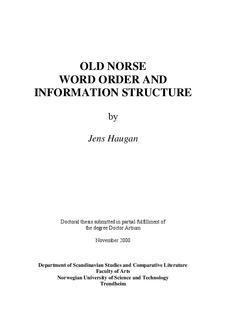| dc.description.abstract | The present work is a study of Old Norse word order and information structure. I am not the first one who has tried to take a closer look at Old Norse word order. To mention only a few of the earliest major works concentrating on word order in Old Norse prose, we must start way back at the end of the nineteenth century, e.g. Lund (1862) or Bernstein (1898). The most important (early) contribution to the study on Old Norse syntax is Nygaard’s (1905) Norrøn syntax, which may still be considered a central piece of work in this particular linguistic field. The earliest works on Old Norse syntax are first of all descriptive and they more or less lack theoretical foundation (at least compared to modern linguistic theories). With the work (on Old Danish syntax) of Diderichsen (1941), the description of Scandinavian syntax in general became more accurate. Diderichsen’s topological model with so-called ‘sentence fields’ (see the discussion in 2.5) is still a useful tool when working with modern (Mainland) Scandinavian, however, in spite of its many limitations.
The two most recent theses on Old Norse syntax that I am aware of are Christoffersen (1993a) and Kristoffersen (1996). The former is based on the Diderichsen tradition. The latter investigation of Old Norse is carried out within the framework of Lexical-Functional Grammar (LFG). In the present thesis, one approach to the syntax of Old Norse will be the theory of Government and Binding (GB), based on Chomsky (1981) and subsequent works by Chomsky and many other linguists. I believe that some syntactic ‘problems’, such as the question whether Old Norse is configurational or not, or whether Old Norse is SVO, SOV or both, can be satisfactorily described and explained within the framework of Government and Binding. The conception of Scandinavian syntax in a generative perspective is based to a great extent on the work of Holmberg & Platzack (1995). The most recent development within GB theory, the so-called Minimalist Program (e.g. Chomsky 1992, 1993, 1995), will be given minimal attention in this work.3
In my discussion on Old Norse syntax, I will also make use of the theory of thematic roles (Fillmore 1968 and later work, Jackendoff 1972 and later work) to a somewhat greater extent than common within GB theory. The mapping between argument structure and the syntactic deep-structure plays an important role in my discussion on Old Norse syntax, and I will show that, for instance, the phenomenon of so-called oblique subjects in Old Norse can be best understood on the background of thematic hierarchies determining the projection of arguments into syntactic structures. The existence of thematic hierarchies combined with contextual demands may have a great effect on surface syntax (information structure), and I will therefore supplement the formal discussion on word order with a more functional discussion, first of all based on Lambrecht (1994). | nb_NO |
